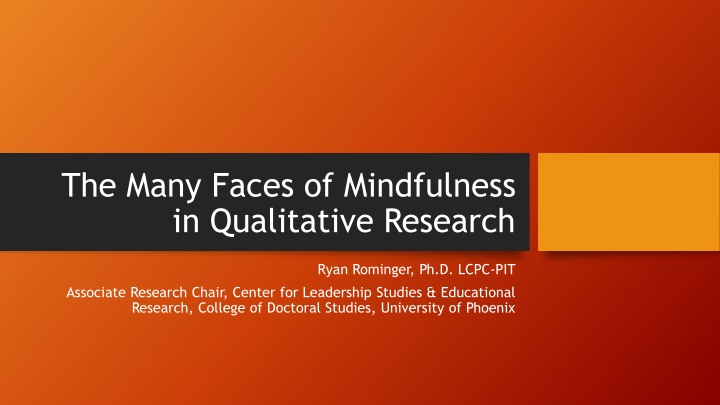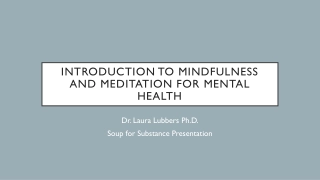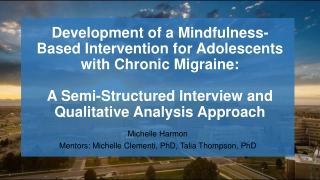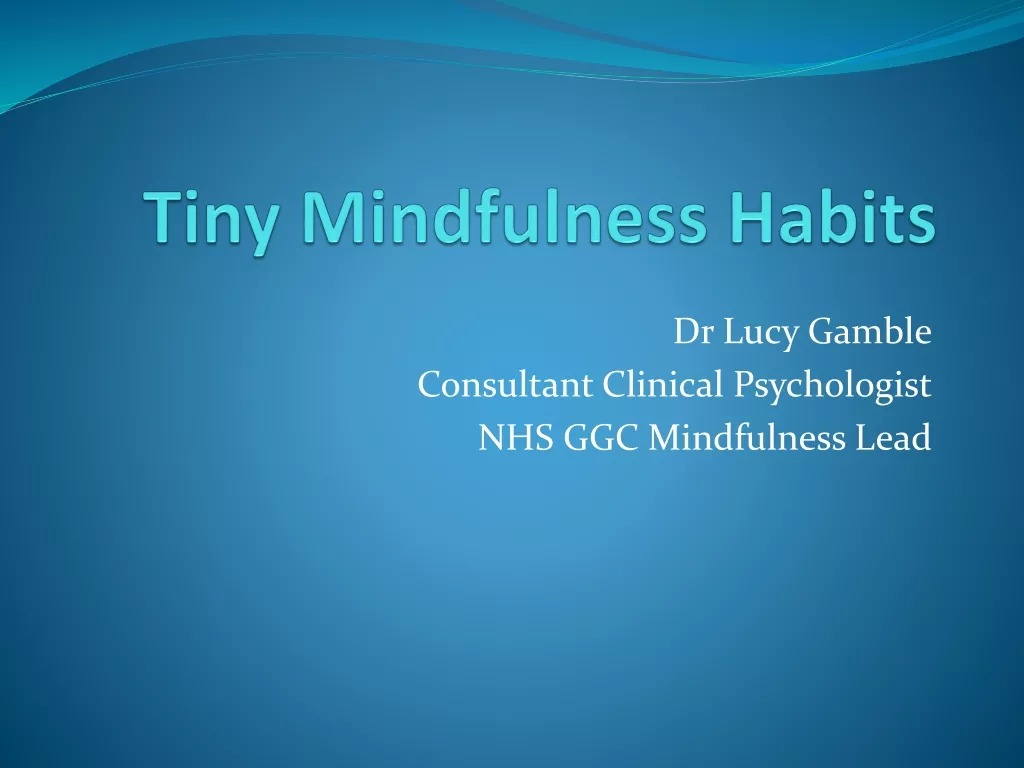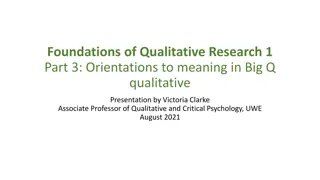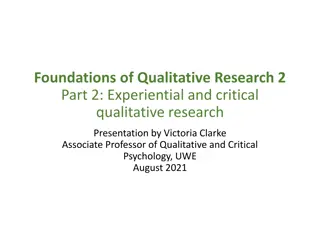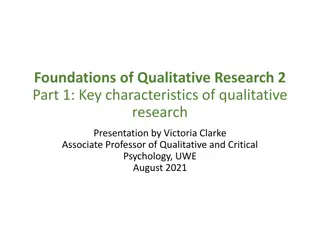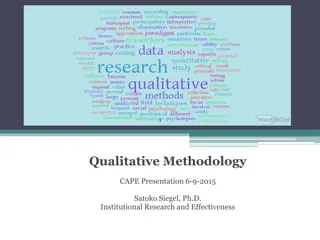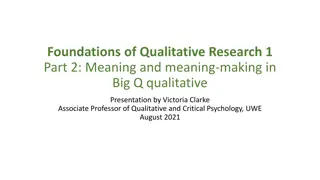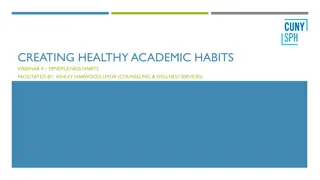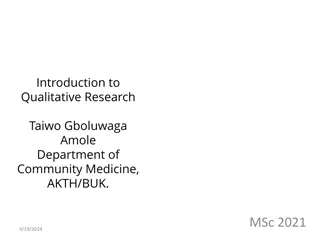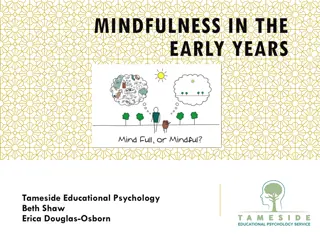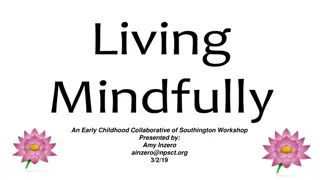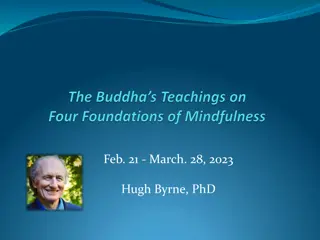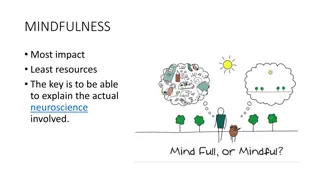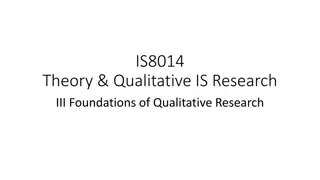Faces of Mindfulness in Qualitative Research: A Comprehensive Perspective
Dive into the multifaceted applications of mindfulness in qualitative research as explained by Dr. Ryan Rominger, providing insightful perspectives on its integration and impact within the field. Discover the diverse aspects and nuances of applying mindfulness practices in qualitative research settings, enhancing understanding of its varied roles and benefits. Explore the depth and breadth of mindfulness in research contexts and gain valuable insights into its practical implications and significance.
Download Presentation

Please find below an Image/Link to download the presentation.
The content on the website is provided AS IS for your information and personal use only. It may not be sold, licensed, or shared on other websites without obtaining consent from the author.If you encounter any issues during the download, it is possible that the publisher has removed the file from their server.
You are allowed to download the files provided on this website for personal or commercial use, subject to the condition that they are used lawfully. All files are the property of their respective owners.
The content on the website is provided AS IS for your information and personal use only. It may not be sold, licensed, or shared on other websites without obtaining consent from the author.
E N D
Presentation Transcript
The Many Faces of Mindfulness in Qualitative Research Ryan Rominger, Ph.D. LCPC-PIT Associate Research Chair, Center for Leadership Studies & Educational Research, College of Doctoral Studies, University of Phoenix
Background MA and Ph.D. Studied, extensively, meditation practices & their effects During certification in spiritual direction studies, trained in different types of meditation practices: guided visualizations, guided relaxations, concentration, awareness, prayer MS in Clinical Mental Health Counseling One of main theoretical models Mindfulness Based Therapies MBCT, Acceptance & Commitment Therapy, Dialectical Behavior Therapy, etc. Co-authored chapter on Mindfulness for stress, anxiety, depression, and chronic pain in older adults release date 2019
Defining Mindfulness Kabat-Zinn (1994) paying attention in a particular way: on purpose, in the present moment, and non- judgmentally (Kabat-Zinn, 1994, p.4) Brown et al. (2013) an open attention to one s present experience and a non-judgmental, accepting attitude toward whatever one encounters (p. 96) Langer and Moldoveanu (2000) mindfulness includes paying attention to novel stimuli whether trivial or important. Siegel (2011) helps people train their brain in order to pay attention to their own attention and intention without becoming reactive.
Quick Experiential Assume relaxed position, sitting with spine erect, hands comfortably in lap Close eyes, or have eyes unfocused about 1.5 ft in front of you (Body Scan) Become aware of feet, legs, hips, back, stomach, arms, hands, shoulders, neck, head (Mindful breathing) Now focus on breath, cycle of inhalation & exhalation, feeling of chest/stomach moving, feeling of air flowing in and out of body. When mind wanders to sounds/thoughts/sensations, refocus on breath without judgment of wandering mind or sounds/thoughts/sensations.
Braud, Anderson, & Transpersonal Research Methods Anderson and Braud (2011), two research methodologists, 3 of 10 critical integral research skills within the human sciences and humanities includes: working with intention: awareness of, and deliberate framing of, intentions for all phases of a research project; facilitates the realization of study aims quieting and slowing: sets stage for use of other skills, relaxes and quiets, reduces distractions and noise at many levels, reduces structures and constrains, allows change, allows further observations and appreciation of more subtle aspects of what is studied working with attention: practice in deploying, focusing, and shifting attention; deautomatizing attention; attending to different forms and channels of information; changing focal plane or magnification of attention; developing witnessing consciousness. (italics in original; pp. 163-164) The authors additionally note that one way to hone these skills is through engagement in different types of meditation, including mindfulness meditation (Anderson & Braud, 2011).
Anderson & Brauds Other Skills Auditory skills (listening to others and own reactions/memories to sound) Visual skills, imagery, visualization, imagination Kinesthetic skills (gross & subtle movements) Proprioceptive skills (paying attention to visceral/muscular) Direct knowing, intuition, empathic identification Accessing unconscious processes and materials (liminal states) Play and the creative arts (novelty, creativity & notice mind)
Fielden & the 5 Stages of Research Fielden (2010) discusses using mindfulness within the five stages of research outlined by Denzin and Lincoln. researcher (topic selection), theory (literature review), strategy (proposal), data collection, and interpretation mindfulness affects cognitive maturity, personal qualities such as intuition and integrity, holistic thinking, knowledge of the self, and intellectual qualities having a flexible mind, tolerating chaos, and understanding multiple viewpoints are important at all stages
Fielden & the 5 Stages of Research Other fruits of mindfulness may be stage specific: qualities such as respect, reverence, and integrity (personality characteristics heightened by mindfulness practice) are particularly important in the data collection stage as a researcher interacts with participants. Meta-awareness, on the other hand, may be particularly important during the interpretation stage Furthermore, a mindful approach to the research process adds a whole being dimensions to the practice of qualitative research in information systems (Fielden, 2010, p. 51).
Lemon & Data Collection Lemon (2017) more specifically addresses applying mindfulness practice to data collection, especially within a phenomenological study Epoche - bracketing process Mindfulness helps researchers understand personal thoughts, emotions, biases, positionality Lemon (2017) notes that researchers who practice mindfulness may recognize the ways in which we may edit our experiences (p. 3308)
Phenomenology & Raw Experience Field of phenomenology has always emphasized the notion of paying close attention to direct, raw experience. (Description) Husserl purposefully placed emphasis upon bracketing judgments and assumptions in a manner that increased awareness of what is given in the flow of immediate human experience. Martin Heidegger (1997/2006), Husserl s prot g , went on to refine Husserl s phenomenological emphasis on direct intuition or presence by incorporating a mindful meditative stance of noninterference that allows the experience of being to unfold naturally. (Felder et al., 2014, pp. 7-8) Daseinsanalysis
Phenomenology & Raw Experience In the hermeneutical phenomenological (Heidegger s) perspective: An additional element of mindfulness was the increased awareness of the interaction between self and context, or thrownness (Davidson, 2013) person and world continuously solicit each other and reflect back upon each other through an ongoing and evolving interrelatedness and entwinement (Felder et al., 2014, p. 19) To be aware of the interaction takes practice and the cultivation of specific skills of awareness, of being aware of self, other, and the interaction or space between
Woodgate, Tennent, Zurba & Ethics Woodgate, Tennent, and Zurba (2017) propose that mindfulness may also be beneficial when considering research ethics. Ethics arises in two main stages: proposal writing/IRB, and during live interactions with participants where ethics becomes enacted It is in the enactment phase where understanding one s own personal reactions (to participants and situations) becomes useful
Woodgate, Tennent, Zurba & Ethics Woodgate et al. (2017) write that: Sustaining mindful presence includes the following characteristics that can become highly developed within a researcher: (i) openness and curiosity, (ii) empathy and acceptance, (iii) receptive attention and deep listening, (iv) relational engagement, (v) flexibility and reflexivity, (vi) self- awareness and self-regulation, and (vii) being nonjudgmental and respectful . (p. 7)
So, where does this leave us? Recommendations 1. To hone qualitative research skills, learn mindfulness techniques 2. Practice those techniques. As many mindfulness practitioners know, real mindfulness does not come from reading about it Not a bystander sport! 3. Where possible, integrate into qualitative research curricula Simple start when teaching interviewing and interview techniques, teach students to practice mindfulness before going into interview so as to be more open, aware, and non-judgmental about what they are hearing Or when engaging in coding & analysis, before starting, practice mindfulness to become open, centered, non-judgmental, aware so as to be open to the themes, emergent codes, and their reactions to the findings May be especially helpful with certain topics (i.e., trauma based topics)
Questions? Send correspondence to Ryan Rominger at drryanrominger@gmail.com
References Anderson, R., & Braud, W. (2011). Transforming self and others through research: Transpersonal research methods and skills for the human sciences and humanities. Albany, NY: State University of New York Press. Brown, A.P., Marquis, A. and Guiffrida, D.A. (2013). Mindfulness-Based interventions in counseling. Journal of Counseling & Development, 91, 96 104. doi:10.1002/j.1556-6676.2013.00077.x. Davidsen, A. S. (2013). Phenomenological Approaches in Psychology and Health Sciences. Qualitative Research in Psychology, 10(3), 318 339. http://doi.org/10.1080/14780887.2011.608466 Felder, A. J., Aten, H. M., Neudeck, J. A., Shiomi-Chen, J., & Robbins, B. D. (2014). Mindfulness at the heart of existential-phenomenology and humanistic psychology: A century of contemplation and elaboration. The Humanistic Psychologist, 42, 6-23. DOI: 10.1080/08873267.2012.753886
References Fielden, K. (2010). Re-conceptualising research: A mindful process for qualitative research in information systems. International Journal of Information Systems and Social Change, 1(1), 44-55. Kabat-Zinn, J. (1982). An outpatient program in behavioral medicine for chronic pain patients based on the practice of mindfulness meditation: Theoretical considerations and preliminary results. General Hospital Psychiatry, 4, 33 47. Kabat-Zinn, J. (1990). Full catastrophe living: Using the wisdom of your body and mind to face stress, pain, and illness. NewYork: Delacorte Press. Kabat-Zinn, J. (1994). Wherever You Go, There You Are: Mindfulness Meditation in Everyday Life. Hyperion, New York. Langer, E. J., & Moldoveanu, M. (2000). The construct of mindfulness. Journal of Social Issues, 56(1), 1-9.
References Lemon, L. (2017). Applying a mindfulness practice to qualitative data collection. The Qualitative Report, 22(12), 3305-3313. Retrieved from http://nsuworks.nova.edu/tqr/vol22/iss12/14 McCarney, R. W., Schulz, J., & Grey, A. R. (2012). Effectiveness of mindfulness-based therapies in reducing symptoms of depression: A meta-analysis. European Journal of Psychotherapy & Counselling, 14(3), 279-299. doi:10.1080/13642537.2012.713186 McCracken L. M., Vowles E. K. (2014). Acceptance and Commitment Therapy and mindfulness for chronic pain model, process, and progress. American Psychologist, 69, 179-187. doi: 10.1037/a0035623 Segal, Z. V., Williams, J. M. G., & Teasdale, J. D. (2002). Mindfulness-based cognitive therapy for depression: A new approach to preventing relapse. New York, NY: Guilford Press.
References Siegel, M. (2011). Mindsight: The new science of personal transformation. New York, NY: Bantam Books. Woodgate, R. L., Tennent, P., & Zurba, M. (2017). Navigating ethical challenges in qualitative research with children and youth through sustaining mindful presence. International Journal of Qualitative Methods, 16, 1-11. DOI: 10.1177/1609406917696743
